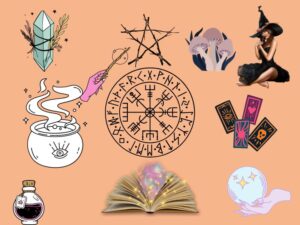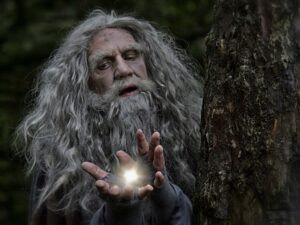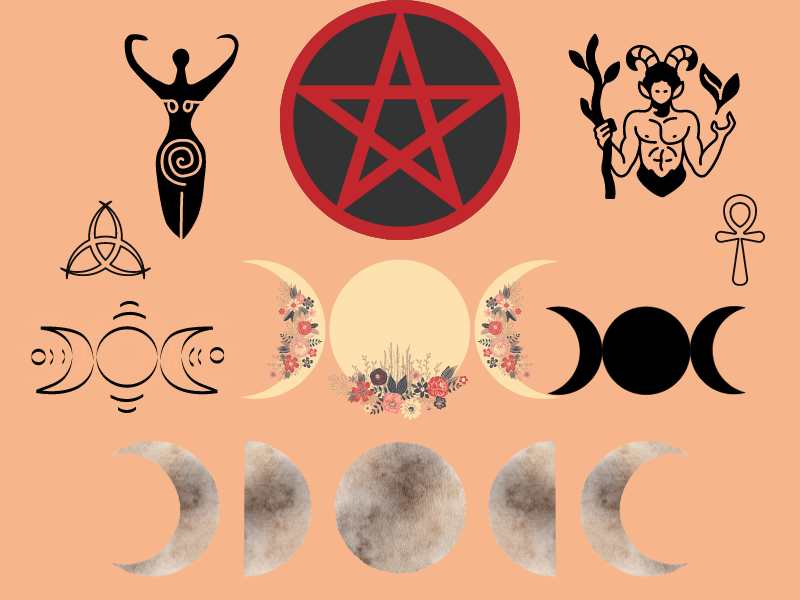Wicca and witchcraft have been a part of human history for thousands of years, and the study of their origins and practices is a fascinating subject. With roots in ancient cultures and pagan traditions, these spiritual paths have evolved over time to become a diverse and vibrant community. In this article, we’ll explore the history and development of Wicca and witchcraft, from their earliest beginnings to the present day. Join us as we delve into the rich cultural heritage of these fascinating spiritual traditions and learn about the beliefs, practices, and rituals that have shaped their evolution.

Wicca and witchcraft are spiritual practices that have been steeped in mystery and folklore for centuries. The origins of these practices can be traced back to ancient cultures such as the Celts, Greeks, and Egyptians, who revered the natural world and the cycles of the seasons. Over time, these pagan traditions blended with the teachings of the medieval Church to form what we know today as Wicca and witchcraft. Despite persecution and suppression throughout history, these practices have persevered and continue to thrive in modern times.
In this article, we’ll delve deeper into the history and development of Wicca and witchcraft, exploring the various beliefs, rituals, and practices that have been passed down through generations. From the use of herbal magic and spells to the celebration of the seasonal festivals and the reverence of the elements, we’ll examine the core tenets of these spiritual traditions. We’ll also look at the diversity within the community, as Wicca and witchcraft have evolved to encompass many different paths and traditions.
Whether you’re a seasoned practitioner or just curious about the subject, this article will provide an in-depth look at the fascinating world of Wicca and witchcraft. So join us as we trace the ancient origins of these spiritual practices and discover the rich cultural heritage that has shaped them into what they are today.

Table of Contents
Wicca and Witchcraft
Wicca and witchcraft are related but distinct spiritual practices. Wicca is a modern pagan, witchcraft-based religion that was founded in England in the mid-20th century. It is centered around the worship of a deity in the form of the Goddess and God, and the celebration of the cycles of the seasons. Wiccans practice rituals and spells, and they place a strong emphasis on the ethical principle of “Do what thou wilt, as long as it harms none.”
Witchcraft, on the other hand, is a broad term that refers to the practice of magic or the use of spells, incantations, and ritual actions to bring about desired outcomes. Witchcraft can be practiced within a religious context (such as Wicca) or as a standalone practice.
Wicca is a religion that incorporates elements of witchcraft, while witchcraft can be practiced as a standalone spiritual practice or as part of another religious tradition.
Wicca is a modern pagan, nature-based religion that was founded in England in the mid-20th century. It is centered around the worship of a deity in the form of the Goddess and God, and the celebration of the cycles of the seasons. Wiccans practice rituals and spells, and they place a strong emphasis on the ethical principle of “Do what thou wilt, as long as it harms none.” Wicca also encompasses a belief in reincarnation and the concept of an afterlife. The religion emphasizes a deep connection to the natural world and the reverence of the elements. It is a decentralized religion with no central authority or hierarchy, and each practitioner is encouraged to develop their own unique spiritual path.
Ancient Origins: Prehistoric Practices
The origins of Wicca and witchcraft can be traced back to prehistoric times, when early human societies revered the forces of nature and practiced animism, the belief in the existence of spiritual entities in all things. These pagan beliefs were passed down through generations and were a part of the cultural heritage of various ancient civilizations, such as the Celts, Greeks, and Egyptians. These cultures believed in the power of magic and the use of spells, incantations, and ritual actions to bring about desired outcomes. They also celebrated the cycles of the seasons and held festivals to mark important events in the agricultural calendar.
As the Roman Empire spread throughout Europe, the pagan beliefs of the indigenous peoples were suppressed, and Christianity became the dominant religion. However, elements of the ancient pagan practices survived, especially in rural communities, and were passed down through generations in the form of folk magic and herbalism. Over time, these beliefs and practices evolved and blended with Christian teachings to form what is now known as Wicca and witchcraft.
Despite centuries of persecution, the ancient practices of Wicca and witchcraft have persevered and continue to be a vibrant part of modern spirituality. Today, practitioners honor the ancient traditions and customs, while also incorporating new beliefs and practices into their spirituality.
Neolithic Rituals: Stone Circles
The Neolithic period saw the rise of early human societies and the development of agriculture, which brought about significant changes in religious practices and beliefs. During this time, stone circles were built as places of worship and ritual, and they remain a mysterious and fascinating part of the ancient cultural heritage of humankind.

Stone circles, such as Stonehenge in England, are believed to have been used for a variety of purposes, including astronomical observations, calendrical rituals, and seasonal festivals. These structures were often aligned with the rising and setting sun and other celestial bodies, and they served as a reminder of the cycles of the natural world and the changing seasons.
The use of stone circles as places of worship and ritual is a significant part of the ancient history of Wicca and witchcraft. The practice of gathering at stone circles for rituals and festivals is still honored today by modern practitioners, who view these structures as a connection to the ancient pagan beliefs and traditions. The construction and alignment of stone circles also speaks to the deep reverence and understanding of the natural world that was held by the people of the Neolithic era, and this connection to nature remains a central part of Wicca and witchcraft today.
Bronze Age Magic: Spellcasting
The Bronze Age saw the rise of complex societies, and with it, an increase in the importance of magic and spellcasting. This period was characterized by the widespread use of metal tools and weapons, and it was a time of great innovation and creativity.
In many ancient cultures, magic was seen as a way to exert control over the forces of nature and the world around them. Spellcasting was used for a variety of purposes, including healing, protection, divination, and bringing about desired outcomes. The use of symbols, ritual gestures, and incantations were all integral components of spellcasting, and these practices were passed down from generation to generation.

The Bronze Age is considered to be a significant period in the history of Wicca and witchcraft, as many of the practices and beliefs that were established during this time have been passed down and continue to be used by modern practitioners. Spellcasting, in particular, remains a central part of Wicca and witchcraft, and it is still used to bring about desired outcomes and to connect with the natural world and the cycles of the seasons. The ancient spells and incantations of the Bronze Age have been adapted and modified over time to meet the needs of contemporary practitioners, and they continue to be an important part of modern Wiccan and witchcraft practices.
Iron Age Connections: Druidism and Shamanism
The Iron Age saw the rise of powerful civilizations and the establishment of religious and spiritual traditions that would have a lasting impact on the world. During this time, two important spiritual movements emerged: Druidism and Shamanism.

Druidism was the spiritual tradition of the Celts, a group of ancient peoples who lived in Europe before the arrival of the Romans. The Druids were the spiritual leaders of their communities, and they held a deep reverence for nature and the cycles of the seasons. They believed in reincarnation and the afterlife, and they practiced divination, magic, and spellcasting.
Shamanism, on the other hand, was a spiritual tradition that was practiced by indigenous peoples across the world. Shamans were seen as intermediaries between the human world and the spiritual realm, and they used ritual, trance, and meditation to communicate with the spirits and bring about healing and balance to their communities.
Both Druidism and Shamanism have had a lasting impact on Wicca and witchcraft, and many modern practitioners honor the ancient traditions and beliefs of these spiritual movements. The reverence for nature, the use of magic and spellcasting, and the belief in the afterlife are all integral parts of modern Wicca and witchcraft, and they can be traced back to the spiritual traditions of the Iron Age.
Today, Wicca and witchcraft continue to evolve and grow, but the ancient connections to Druidism and Shamanism remain a vital part of the spiritual heritage of modern practitioners. The practices and beliefs of these ancient spiritual traditions continue to inspire and inform the spirituality of Wicca and witchcraft, and they are an important part of the ongoing legacy of these ancient spiritual movements.
Middle Ages Beliefs: Witches and Warlocks
The Middle Ages were a time of great change and upheaval in Europe, and they saw the development of new beliefs and attitudes towards magic and spirituality. During this time, the concept of the “witch” and “warlock” emerged, and these figures came to be associated with evil and sorcery.

In the Middle Ages, witchcraft was widely feared and persecuted. The Church and the state saw witchcraft as a threat to the social and political order, and they accused practitioners of consorting with the devil and engaging in evil acts. Many thousands of people were put on trial and executed for witchcraft, and the fear and suspicion of witchcraft spread throughout Europe.
Despite the persecution, however, the practice of magic and witchcraft continued in secret, passed down from generation to generation. The beliefs and practices of the Middle Ages have had a lasting impact on the modern understanding of Wicca and witchcraft, and many contemporary practitioners honor the memory of those who were persecuted and killed for their beliefs.
Today, Wicca and witchcraft are no longer seen as dangerous or evil, and they have been largely accepted as valid spiritual practices. The fear and suspicion that characterized the Middle Ages have been replaced by a new appreciation for the diversity of spiritual beliefs and practices, and Wicca and witchcraft are now widely recognized as valid spiritual paths.
The Middle Ages were a critical period in the history of Wicca and witchcraft, and they continue to shape the beliefs and practices of modern practitioners. The legacy of persecution and fear that characterized the Middle Ages has been transformed into a new understanding and appreciation of the diversity of spiritual beliefs and practices, and Wicca and witchcraft continue to evolve and grow as valid spiritual paths.
Modern Witchcraft: Wicca Revival
The modern revival of Wicca and witchcraft can be traced back to the early 20th century, when a new generation of spiritual seekers began to rediscover the ancient traditions of magic and spirituality.

One of the key figures in this revival was Gerald Gardner, a British occultist and author who is widely regarded as the father of modern Wicca. Gardner was fascinated by the history and lore of witchcraft, and he worked to revive the ancient practices and beliefs of the craft. He drew upon a wide range of influences, including Druidism, Shamanism, and the esoteric traditions of Europe, to create a new form of witchcraft that he called Wicca.
Gardner’s Wicca was based on the worship of the Goddess and the God, and it emphasized the power of magic, ritual, and spellcasting. He saw Wicca as a spiritual path that was in harmony with nature, and he encouraged practitioners to develop a deep connection with the natural world.
Since Gardner’s time, Wicca has continued to evolve and grow, and it has become one of the largest and most influential forms of witchcraft in the world. Today, Wicca is practiced by millions of people around the world, and it continues to inspire and inform the spiritual journeys of countless others.
It has been a remarkable and transformative movement, and it continues to shape the spiritual landscape of the world. From its humble beginnings in the early 20th century, Wicca has become a powerful and influential spiritual tradition that celebrates the magic and mystery of the natural world.
The Wicca and witchcraft in the 20th century has been accompanied by a growing interest in alternative spirituality and new religious movements. Many people are attracted to Wicca and witchcraft for its focus on personal growth and self-discovery, as well as its celebration of the divine feminine and the connection with nature.
In addition, the modern revival of Wicca and witchcraft has also been influenced by a growing awareness of feminist and environmental issues. For many practitioners, Wicca represents a spiritual path that is inclusive, empowering, and respectful of the natural world.
The revival has also been influenced by popular culture, and Wicca and witchcraft have been featured in a wide range of books, movies, and television shows. These depictions have helped to raise awareness of Wicca and witchcraft, and they have contributed to a growing interest in these spiritual traditions.
Conclusion: Wicca and Witchcraft Survival
In conclusion, Wicca and witchcraft have a rich and complex history that stretches back thousands of years. Despite centuries of persecution and suppression, these ancient spiritual traditions have survived and continue to thrive in the modern world.
The modern revival of Wicca and witchcraft has been driven by a growing interest in alternative spirituality and a desire for a deeper connection with nature and the divine. Today, Wicca and witchcraft are practiced by millions of people around the world, and they continue to inspire and inform the spiritual journeys of countless others.
In a rapidly changing world, Wicca and witchcraft offer a powerful and transformative spiritual path for those who seek to deepen their connection with the natural world and to celebrate the magic and mystery of life. Whether tracing their roots back to ancient times or embracing new forms of expression in the modern era, Wicca and witchcraft are a testament to the resilience and vitality of the human spirit, and they will continue to thrive for generations to come.
blessings
Mind, Body & Soul Doctor
Psychic Medium, Paranormal Expert, Spiritual Counselor, Life Coach, Relationship Healer, Wiccan Spell Caster
Website: for Tarot and Divination: http://www.indiatarot.com,
for Wicca & Witchcraft Courses: http://www.wiccaindia.com
for Wicca / witchcraft shop you may like to visit : shop



